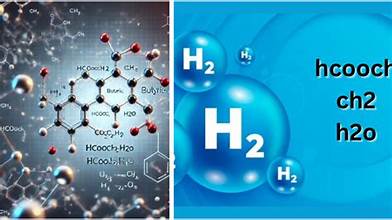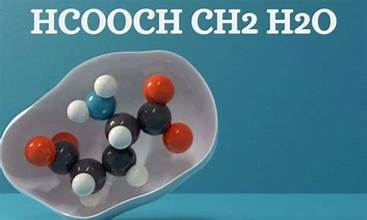Introduction to HCOOCH CH2 H2O and Its Components
The chemical formula HCOOCH CH2 H2O represents a molecule containing ester and water components. This compound is of significant interest in the study of organic chemistry and biochemistry due to its structure, functionality, and its role in various chemical reactions. To understand HCOOCH CH2 H2O fully, it’s important to break down its individual components and explore its role in both synthetic and natural processes.
In this article, we will explore the structure and reactivity of HCOOCH CH2 H2O, its potential uses in the chemical industry, and its significance in biological systems. Additionally, we will delve into how this compound is synthesized and used in various applications, shedding light on its importance in everyday life and in scientific research.
Table of Contents
What is HCOOCH CH2 H2O?
The molecule HCOOCH CH2 H2O consists of three main parts: a formate ester group (HCOO), a methylene group (CH2), and a water molecule (H2O). This structure is often encountered in the context of ester hydrolysis reactions, where an ester reacts with water, breaking down into an alcohol and an acid.
HCOOCH CH2 H2O can be thought of as a hydrolyzed ester where the ester group has reacted with water to form an alcohol and an organic acid. The formate ester component (HCOO) plays a critical role in the compound’s behavior, while the CH2 group links the ester to the water molecule.
Chemical Structure of HCOOCH CH2 H2O
The chemical structure of HCOOCH CH2 H2O can be broken down into its individual elements. The HCOO group is a formate ester, where the hydrogen atom is attached to a carboxyl group (COO), and the CH2 represents a methylene group, which is commonly found in many organic compounds.
When HCOOCH CH2 H2O undergoes hydrolysis, the bond between the ester group and the CH2 group is broken, resulting in the formation of an alcohol (CH2OH) and a formic acid molecule (HCOOH). This reaction is important in many biological and industrial processes, particularly those involving ester cleavage and the production of alcohols.
The Role of HCOOCH CH2 H2O in Ester Hydrolysis

One of the primary areas where HCOOCH CH2 H2O is relevant is in the field of ester hydrolysis. In ester hydrolysis reactions, an ester reacts with water to produce an alcohol and an acid. This reaction is catalyzed by either an acid or a base, and it is a key reaction in both synthetic and biological systems.
For example, HCOOCH CH2 H2O can undergo hydrolysis in the presence of an acid to produce methanol and formic acid:
HCOOCH CH2 H2O → CH2OH + HCOOH
This reaction is important in the breakdown of ester compounds in the body, as well as in the industrial production of alcohols and acids.
Applications of HCOOCH CH2 H2O in Industrial Chemistry
The compound HCOOCH CH2 H2O has several potential applications in industrial chemistry. One of the most significant uses is in the production of alcohols and organic acids. The hydrolysis of formate esters such as HCOOCH CH2 H2O leads to the production of methanol, which is used in a variety of industrial applications, including the manufacture of plastics, paints, and solvents.
Additionally, the breakdown of HCOOCH CH2 H2O into formic acid has implications in the chemical industry. Formic acid is a valuable chemical used in the production of textiles, leather, and rubber, as well as in various chemical reactions such as the reduction of metals and the synthesis of other chemicals.
HCOOCH CH2 H2O in Biological Systems
HCOOCH CH2 H2O is also relevant in biological systems, particularly in the context of enzymatic hydrolysis. Many enzymes in the body are capable of catalyzing the hydrolysis of esters, including formate esters like HCOOCH CH2 H2O. This process is essential for the breakdown of various biomolecules and the production of useful metabolites such as alcohols and acids.
For example, in the digestion of fats and oils, ester bonds are hydrolyzed by enzymes like lipases to release fatty acids and alcohols. While HCOOCH CH2 H2O is not a direct participant in the digestion of triglycerides, it serves as a good model compound for understanding ester hydrolysis in living organisms.
Hydrolysis of HCOOCH CH2 H2O in Aqueous Environments

In aqueous environments, the hydrolysis of HCOOCH CH2 H2O is a straightforward example of an ester undergoing a chemical reaction with water. The reaction mechanism involves the breaking of the ester bond and the subsequent formation of an alcohol and an acid. In the presence of water, the ester bond between the formate group (HCOO) and the methylene group (CH2) is cleaved, leading to the production of methanol (CH2OH) and formic acid (HCOOH).
The hydrolysis of HCOOCH CH2 H2O in water is an important process in both synthetic chemistry and biochemistry. It is used to synthesize alcohols and acids, which are essential building blocks in the production of various chemicals and pharmaceuticals.
Environmental Impact of HCOOCH CH2 H2O
The environmental impact of HCOOCH CH2 H2O is also a critical consideration, especially in the context of industrial and agricultural applications. When formate esters such as HCOOCH CH2 H2O are released into the environment, they can undergo hydrolysis, leading to the formation of methanol and formic acid. These compounds are biodegradable and do not persist in the environment for long periods.
However, the release of large quantities of formic acid or methanol into ecosystems could potentially have negative effects. For example, formic acid is an organic acid that can lower the pH of soil or water, potentially harming plant and animal life. Similarly, methanol is toxic to aquatic organisms and can disrupt the balance of aquatic ecosystems if present in high concentrations.
HCOOCH CH2 H2O in the Production of Bioplastics
An interesting area where HCOOCH CH2 H2O is making an impact is in the development of bioplastics. The hydrolysis of formate esters like HCOOCH CH2 H2O can be used to produce methanol and formic acid, both of which can be utilized in the synthesis of biodegradable plastics. These plastics are gaining popularity as sustainable alternatives to traditional petroleum-based plastics, as they can break down more easily in the environment.
By incorporating renewable resources and sustainable production methods, bioplastics derived from compounds like HCOOCH CH2 H2O offer a promising solution to the growing concerns over plastic pollution. The use of bio-based feedstocks for the production of plastics is an important step toward reducing our dependence on fossil fuels and mitigating the environmental impact of plastic waste.
Future Directions in Research on HCOOCH CH2 H2O
As we continue to explore the chemistry of compounds like HCOOCH CH2 H2O, future research will likely focus on improving the efficiency of ester hydrolysis reactions, developing new catalysts, and finding innovative uses for the products of these reactions. Additionally, the role of HCOOCH CH2 H2O in biochemical pathways could be further elucidated, providing insights into how organisms break down esters and utilize the resulting metabolites.
There is also significant potential for the development of new materials and chemicals derived from compounds like HCOOCH CH2 H2O. For example, the synthesis of biodegradable plastics and green solvents using formate esters and their hydrolysis products could play a significant role in addressing environmental challenges associated with plastic waste and chemical pollution.
Also read Authority Confirms Oak Island Mystery Solved: The Final Revelation
Conclusion
In conclusion, HCOOCH CH2 H2O is a fascinating compound that serves as an important example of ester hydrolysis and its role in both industrial and biological processes. From its potential applications in the production of methanol and formic acid to its use in bioplastics and other sustainable materials, HCOOCH CH2 H2O has wide-ranging implications for both chemistry and environmental science.
As research on ester hydrolysis and the uses of formate esters continues to advance, we can expect to see new and innovative applications of compounds like HCOOCH CH2 H2O, contributing to the development of sustainable technologies and processes that will benefit industries, ecosystems, and society as a whole.


